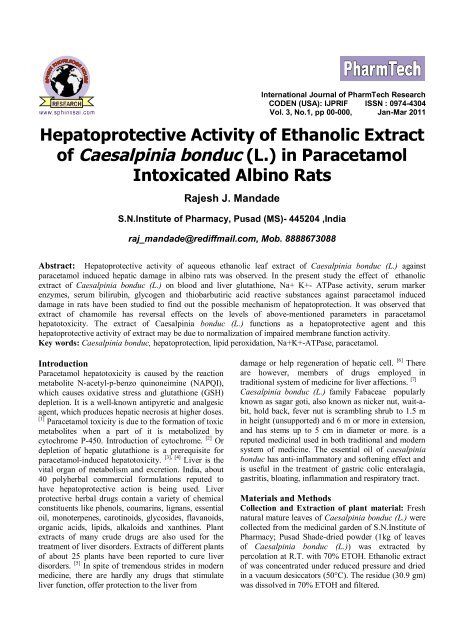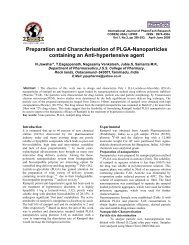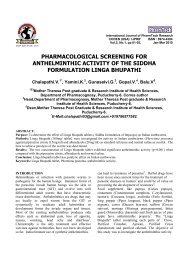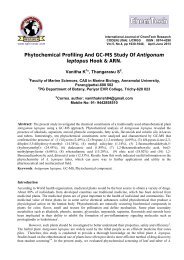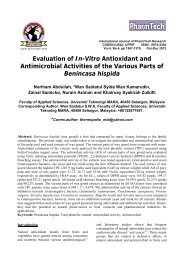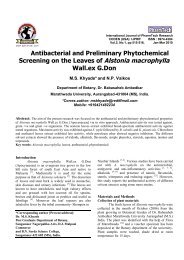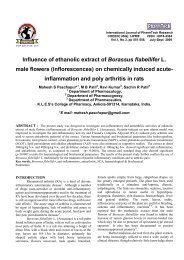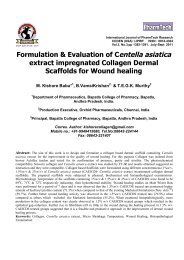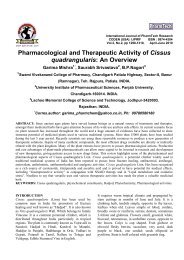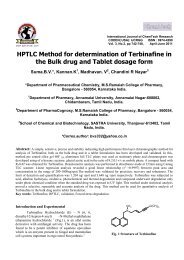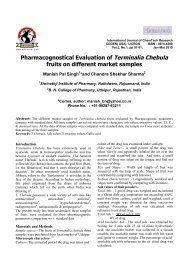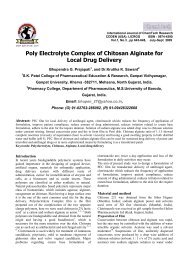of Caesalpinia bonduc - Research Journal Chemistry, ChemTech ...
of Caesalpinia bonduc - Research Journal Chemistry, ChemTech ...
of Caesalpinia bonduc - Research Journal Chemistry, ChemTech ...
You also want an ePaper? Increase the reach of your titles
YUMPU automatically turns print PDFs into web optimized ePapers that Google loves.
International <strong>Journal</strong> <strong>of</strong> PharmTech <strong>Research</strong><br />
CODEN (USA): IJPRIF ISSN : 0974-4304<br />
Vol. 3, No.1, pp 00-000, Jan-Mar 2011<br />
Hepatoprotective Activity <strong>of</strong> Ethanolic Extract<br />
<strong>of</strong> <strong>Caesalpinia</strong> <strong>bonduc</strong> (L.) in Paracetamol<br />
Intoxicated Albino Rats<br />
Rajesh J. Mandade<br />
S.N.Institute <strong>of</strong> Pharmacy, Pusad (MS)- 445204 ,India<br />
raj_mandade@rediffmail.com, Mob. 8888673088<br />
Abstract: Hepatoprotective activity <strong>of</strong> aqueous ethanolic leaf extract <strong>of</strong> <strong>Caesalpinia</strong> <strong>bonduc</strong> (L.) against<br />
paracetamol induced hepatic damage in albino rats was observed. In the present study the effect <strong>of</strong> ethanolic<br />
extract <strong>of</strong> <strong>Caesalpinia</strong> <strong>bonduc</strong> (L.) on blood and liver glutathione, Na+ K+- ATPase activity, serum marker<br />
enzymes, serum bilirubin, glycogen and thiobarbutiric acid reactive substances against paracetamol induced<br />
damage in rats have been studied to find out the possible mechanism <strong>of</strong> hepatoprotection. It was observed that<br />
extract <strong>of</strong> chamomile has reversal effects on the levels <strong>of</strong> above-mentioned parameters in paracetamol<br />
hepatotoxicity. The extract <strong>of</strong> <strong>Caesalpinia</strong> <strong>bonduc</strong> (L.) functions as a hepatoprotective agent and this<br />
hepatoprotective activity <strong>of</strong> extract may be due to normalization <strong>of</strong> impaired membrane function activity.<br />
Key words: <strong>Caesalpinia</strong> <strong>bonduc</strong>, hepatoprotection, lipid peroxidation, Na+K+-ATPase, paracetamol.<br />
Introduction<br />
Paracetamol hepatotoxicity is caused by the reaction<br />
metabolite N-acetyl-p-benzo quinoneimine (NAPQI),<br />
which causes oxidative stress and glutathione (GSH)<br />
depletion. It is a well-known antipyretic and analgesic<br />
agent, which produces hepatic necrosis at higher doses.<br />
[1] Paracetamol toxicity is due to the formation <strong>of</strong> toxic<br />
metabolites when a part <strong>of</strong> it is metabolized by<br />
cytochrome P-450. Introduction <strong>of</strong> cytochrome. [2] Or<br />
depletion <strong>of</strong> hepatic glutathione is a prerequisite for<br />
paracetamol-induced hepatotoxicity. [3], [4] Liver is the<br />
vital organ <strong>of</strong> metabolism and excretion. India, about<br />
40 polyherbal commercial formulations reputed to<br />
have hepatoprotective action is being used. Liver<br />
protective herbal drugs contain a variety <strong>of</strong> chemical<br />
constituents like phenols, coumarins, lignans, essential<br />
oil, monoterpenes, carotinoids, glycosides, flavanoids,<br />
organic acids, lipids, alkaloids and xanthines. Plant<br />
extracts <strong>of</strong> many crude drugs are also used for the<br />
treatment <strong>of</strong> liver disorders. Extracts <strong>of</strong> different plants<br />
<strong>of</strong> about 25 plants have been reported to cure liver<br />
disorders. [5] In spite <strong>of</strong> tremendous strides in modern<br />
medicine, there are hardly any drugs that stimulate<br />
liver function, <strong>of</strong>fer protection to the liver from<br />
damage or help regeneration <strong>of</strong> hepatic cell. [6] There<br />
are however, members <strong>of</strong> drugs employed in<br />
traditional system <strong>of</strong> medicine for liver affections. [7]<br />
<strong>Caesalpinia</strong> <strong>bonduc</strong> (L.) family Fabaceae popularly<br />
known as sagar goti, also known as nicker nut, wait-abit,<br />
hold back, fever nut is scrambling shrub to 1.5 m<br />
in height (unsupported) and 6 m or more in extension,<br />
and has stems up to 5 cm in diameter or more. is a<br />
reputed medicinal used in both traditional and modern<br />
system <strong>of</strong> medicine. The essential oil <strong>of</strong> caesalpinia<br />
<strong>bonduc</strong> has anti-inflammatory and s<strong>of</strong>tening effect and<br />
is useful in the treatment <strong>of</strong> gastric colic enteralagia,<br />
gastritis, bloating, inflammation and respiratory tract.<br />
Materials and Methods<br />
Collection and Extraction <strong>of</strong> plant material: Fresh<br />
natural mature leaves <strong>of</strong> <strong>Caesalpinia</strong> <strong>bonduc</strong> (L.) were<br />
collected from the medicinal garden <strong>of</strong> S.N.Institute <strong>of</strong><br />
Pharmacy; Pusad Shade-dried powder (1kg <strong>of</strong> leaves<br />
<strong>of</strong> <strong>Caesalpinia</strong> <strong>bonduc</strong> (L.)) was extracted by<br />
percolation at R.T. with 70% ETOH. Ethanolic extract<br />
<strong>of</strong> was concentrated under reduced pressure and dried<br />
in a vacuum desiccators (50°C). The residue (30.9 gm)<br />
was dissolved in 70% ETOH and filtered.
Rajesh J. Mandade/Int.J. PharmTech Res.2011,3(1) 432<br />
Animals: Albino rats <strong>of</strong> either sex (120-150 gm) were<br />
maintained under control conditions <strong>of</strong> light and<br />
temperature (25°C+1°C) in animal house <strong>of</strong> S.N.<br />
Institute <strong>of</strong> Pharmacy, Pusad. Food pellets and tap<br />
water were provided ad labium. For experimental,<br />
animals were kept fasting overnight but were allowed<br />
free access to water.<br />
Paracetamol toxicity: The ethanolic extract,<br />
paracetamol, saline were given with the help <strong>of</strong><br />
feeding cannels. Three groups (Group I, Group II and<br />
III) <strong>of</strong> rats, six rats in each group were taken. The C.<br />
<strong>bonduc</strong> (L.) extract at a fixed dose (400 mg kg_ 1,<br />
P.O.) that was daily fed for seven days to one group<br />
(Group III) <strong>of</strong> rats and paracetamol (200 mg kg_ 1<br />
P.O.) was administered on 5th day after 5th<br />
administration <strong>of</strong> the extract. The paracetamol treated<br />
group (Group II) received normal saline in place <strong>of</strong> C.<br />
<strong>bonduc</strong> (L.) extract. After 48h <strong>of</strong> paracetamol feeding<br />
rats were sacrificed by cervical dislocation for<br />
estimation <strong>of</strong> blood glutathione, reduced liver<br />
glutathione, liver Na+K+- ATPase activity, serum<br />
marker enzymes, serum bilirubin and liver<br />
thiobarbutiric acid reactive substances using standard<br />
methods.<br />
Assay <strong>of</strong> liver glutathione and blood glutathione:<br />
Blood was collected, allowed to clot and serum<br />
separated. Liver was dissected out and used for<br />
biochemical studies. Freshly collected livers were<br />
washed with 0.9% NaCl, weighed and homogenates<br />
were made in a ratio <strong>of</strong> 1g <strong>of</strong> wet tissue to 9ml <strong>of</strong><br />
1.25% KCl by using motor driven Teflon-pestle.<br />
Reduced glutathione (GSH) was estimated using<br />
DTNB. [8] The blood glutathione was estimated by the<br />
method <strong>of</strong> Beutler. [9] The absorbance was read at 412<br />
nm.<br />
Liver Na+ K+-ATPase activity: To measure the liver<br />
Na+K+ -ATPase activity the liver was dissected out<br />
quickly, rinsed with cold phosphate buffer, liver<br />
plasma membranes were isolated and subjected for the<br />
estimation <strong>of</strong> Na+ K+-ATPase activity. [10]<br />
Thiobarbutiric acid reactive substances (TBARS):<br />
The concentration <strong>of</strong> TBARS was measured in liver<br />
[11]<br />
using the method <strong>of</strong> Ohkawa et al. the<br />
concentration <strong>of</strong> TBARS was expressed as “moles <strong>of</strong><br />
malondialdehyde per mg <strong>of</strong> protein using 1,1,3,3, -<br />
tetraethoxypropane as the standard.<br />
Serum marker enzymes: The serum alanine<br />
aminotransferase (ALT), aspartate aminotransferase<br />
(AST), alkaline phosphatase (ALP) [12], [13] total serum<br />
protein (TSP) [14] and bilirubin [15] were measured.<br />
Glycogen (GLY) [16] and protein were estimated in<br />
liver homogenate.<br />
Statistical analysis: The data were expressed as mean<br />
= S.E.M. and statistically assessed by one-way<br />
analysis <strong>of</strong> variance (ANOVA). The difference<br />
between drug treated animals and controls was<br />
evaluated by student’s t-test.<br />
Table 1: Effect <strong>of</strong> <strong>Caesalpinia</strong> <strong>bonduc</strong> extract on blood and liver glutathione (GSH), liver Na+K+-ATPase,<br />
serum marker enzymes (ALT, AST, ALP) and liver thiobabutiric acid reactive substances (TBARS) in<br />
Paracetamol intoxicated albino rats<br />
Parameters Group I Group II Group III<br />
Blood GSH (mg%) 1.56± 0.06a 0.37 ± 0.05 1.37 ± 0.04 c<br />
Na+K+-ATPase (U mg_1 protein) 7.16 ± 0.52a 6.11 ± 0.17 8.01±0.16c<br />
Liver GSH (_moles g_1 liver) 10.98± 0.32c 6.02 ± 0.32 9.92± .18b<br />
TBARS (n mol <strong>of</strong> MDA g_1 <strong>of</strong> wet tissue h_1) 282.7 ± 9.36 564.4a ± 9.1 279.7c± 7.20<br />
ALP (KA unit) 59.3±7.2b 99.2±6.75 55.9±2.2<br />
ALT (U mg_1 protein) 61.2±1.06c 237.4±10.9 43.61±1.89c<br />
AST (U mg_1 protein) 69.4±2.01a 172.8±18.1 44.5±1.01b<br />
Bilirubin (mg %) (Total) 1.43±0.12a 2.89±0.10 1.33±0.16b<br />
TSP (mg protein mL_1 serum) 57.89±2.6a 58.12±2.16 62.5±1.99c<br />
GLY (mg g_1 wet tissue) 30.10 ± 2.84a 22.45 ± 1.18 30.49±2.34c<br />
Body weight<br />
Before treatment (g) 147±3a 148.6±2 146±4c<br />
After treatment (g) 158±5b 149.3±3 161±7b<br />
Liver weight (g) 6.89±0.3 5.78±0.6 6.45±0.5b<br />
Results are mean <strong>of</strong> six observations S.E.M.<br />
a p
Rajesh J. Mandade/Int.J. PharmTech Res.2011,3(1) 433<br />
Results and Discussion<br />
The glutathione level in liver homogenate and in<br />
blood, liver Na+K+-ATPase, serum marker enzymes<br />
and liver thiobarbutiric acid reactive substances are<br />
given in Table 1. The concentration <strong>of</strong> GSH in animals<br />
treated with paracetamol was significantly (p
Rajesh J. Mandade/Int.J. PharmTech Res.2011,3(1) 434<br />
References:<br />
1. Boyd E.H. and G.M. Bereczky., Liver necrosis<br />
from paracetamol. Br. J. Pharmacol., 1966, 26,<br />
606-614.<br />
2. Dahlin D., Miwa G., Lu A. and S. Nelson.,<br />
Nacetyl- p-benzoquinone imine: A cytochrome P-<br />
450- mediated oxidation product <strong>of</strong><br />
acetaminophen. Proc. Natl. Acad. Sci., 1984, 81,<br />
1327-1331.<br />
3. Moron M.S., Depierre J.W. and B. Mannervik.,<br />
Levels <strong>of</strong> glutathione, glulathione reductase and<br />
glutathione-S-transferase activities in rat lung and<br />
liver. Biochim. Biophys. Acta, 1979, 582, 67-78.<br />
4. Gupta A.K., Chitme H., S.K. Dass and N. Misra.,<br />
Hepatoprotective activity <strong>of</strong> Rauwolfia serpentina<br />
rhizome in paracetamol intoxicated rats. J.<br />
Pharmacol. Toxicol., 2006, 1, 82-88.<br />
5. Sharma S.K., Ali M. and J. Gupta.,<br />
Phytochemistry and Pharmacology, 2002, 2, 253-<br />
270.<br />
6. Chaterjee T.K., Medicinal Plants with<br />
Hepatoprotective Properties. Herbal Options.<br />
Books & Allied (P) Ltd., Calcutta, 2000, 155.<br />
7. Chattopadhyay R.R., Possible mechanism <strong>of</strong><br />
hepatoprotective activity <strong>of</strong> Azadirachta indica<br />
leaf extract: Part II. J. Ethanopharmacol., 2003, 89,<br />
217-219.<br />
8. Sedlak J. and Lindasy R.H., Estimation <strong>of</strong> blood<br />
protein bound sulphydryl groups in tissue with<br />
Ellman’s reagent. Anal. Biochem., 1968, 25, 192-<br />
197.<br />
9. Beutler E., Duran O. and B.M. Kelly., Improved<br />
method for the determination <strong>of</strong> blood glutathione.<br />
J. Lab. Clin. Med., 1963, 61, 882.<br />
10. Corcoram G.B., Chang S.J. and D.E. Salazar.,<br />
Early inhibition <strong>of</strong> Na+K+-ATPase ion pump<br />
during acetaminophen induced hepatotoxicity in<br />
rats. Biochem. Biophys. Res. Commun., 1987,<br />
149, 203-207.<br />
*****<br />
11. Ohkawa H., Onishi N. and K. Yagi., Assay <strong>of</strong> lipid<br />
peroxidation in animal tissue by thiobarbituric acid<br />
reaction. Anal. Biochem., 1979,95, 351–354.<br />
12. Reitman S. and Frankel S., In vitro determination<br />
<strong>of</strong> tranaminase activity in serum. Am. J. Clin.<br />
Pathol., 1957, 28, 56.<br />
13. Kind P.R.N. and E.J. King., Estimation <strong>of</strong> plasma<br />
phosphatase by determination <strong>of</strong> hydrolysed<br />
phenol with amino antipyrine. J. Clin. Pathol.,<br />
1954, 7, 322.<br />
14. Bradford M.M., A rapid and sensitive method for<br />
the quantitation <strong>of</strong> microgram quantities <strong>of</strong> protein<br />
utilizing the principle <strong>of</strong> protein-dye binding.<br />
Anal. Biochem., 1976, 72, 248-254.<br />
15. Jendrassik, L. and Gr<strong>of</strong> P., Biochemische<br />
Zeitschrift, 1938, 297, 81-89.<br />
16. Hassid, W.Z. and S. Abraham., Chemical<br />
Procedures for Analysis <strong>of</strong> Polysaccarides. In:<br />
Colowick, S.P., Kaplan, N.O. (Eds.), Methods in<br />
Enzymology, Academic Press Inc., New York,<br />
1957, 3, 34.<br />
17. Mitchell, J.R., Jollow D.J., Potter W.Z., Gillettee<br />
J.R. and Brodie B.N., Acetaminophen-induced<br />
hepatic necrosis. I. Role <strong>of</strong> drug metabolism. J.<br />
Pharmacol. Expl. Therap., 1973, 187, 185-194.<br />
18. Eriksson, L., U. Broome, Kahn M. and Lindholm<br />
M., Hepatotoxicity due to repeated intake <strong>of</strong> low<br />
doses <strong>of</strong> paracetamol. J. Inter. Med., 1992, 231,<br />
567-570.<br />
19. Ahmed, M.B. and Khater M.R., Evaluation <strong>of</strong> the<br />
protective potential <strong>of</strong> Ambrosia maritime extract<br />
on acetaminophen-induced liver damage. J.<br />
Ethanopharmacol., 2001, 75, 169-174.<br />
20. Visen, P.K.S., Shukla B., Patnaik G.K. and<br />
Dhawan B.N., Andrographolide protects rat<br />
hepatocytes against paracetamol-induced damage.<br />
J. Ethnopharmacol., 1993, 40, 131-136.


